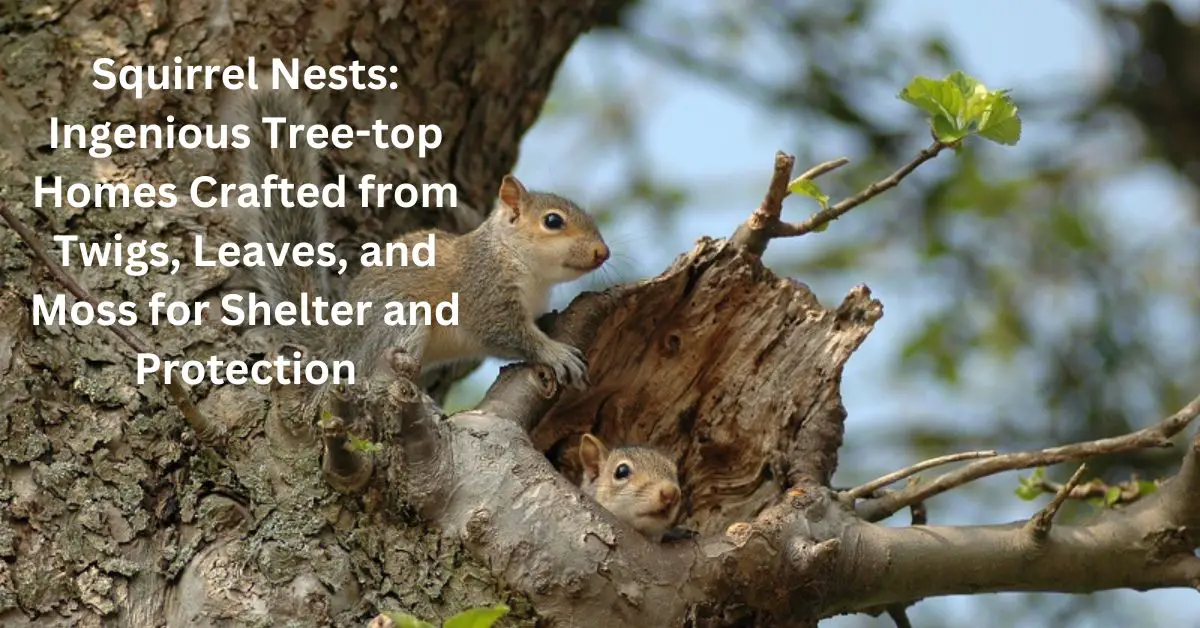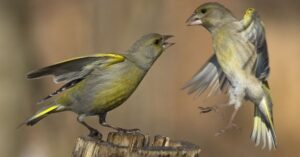In the dappled light of an autumn afternoon, a curious sight often emerges among the branches of towering trees: the intricate architecture of squirrel nests. These cozy abodes, crafted with remarkable skill and precision, serve as a testament to nature’s ingenuity.
But what exactly goes into building a squirrel nest, and how do these industrious creatures choose their locations? Understanding the world of squirrel nests not only sheds light on their fascinating habits but also offers insights into the broader ecosystem in which they thrive.
Squirrel nests can be found in various forms—some are made entirely from twigs and leaves, while others incorporate materials like moss or even bits of human debris.
Types Of Squirrel Nests
Squirrels exhibit remarkable adaptability when it comes to constructing their nests, known as dreys, which can be found high up in trees or tucked away in cozy cavities. These nests serve multiple purposes; they provide shelter from harsh weather conditions and a safe space for raising young.
Typically made of twigs, leaves, and moss, a well-built squirrel’s nest can withstand the elements while offering an inviting environment for its inhabitants. Interestingly, grey squirrels often choose to build their nests closer to human habitats, capitalizing on the abundance of food sources available in parks and backyards.
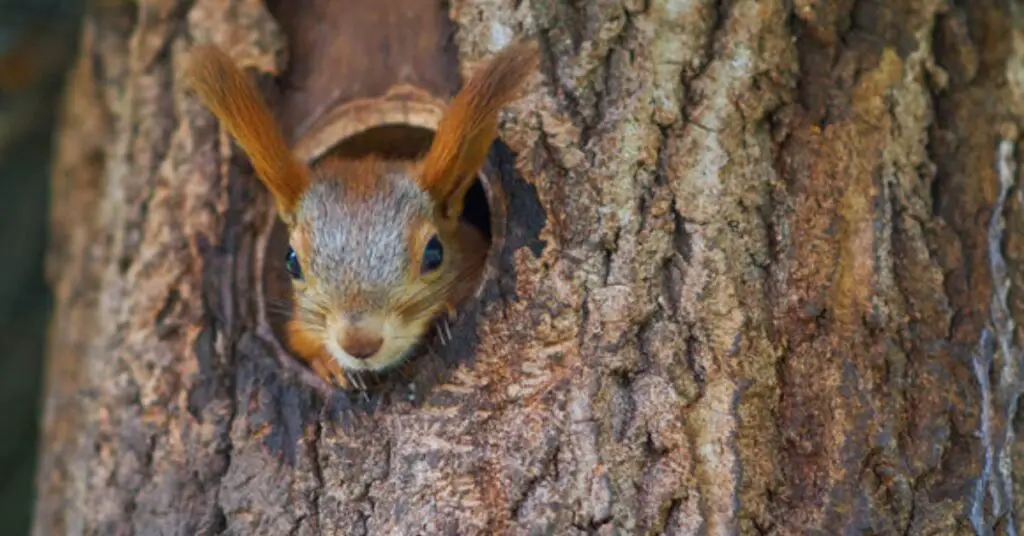
Inside squirrel nest structures is equally fascinating; the interior serves not only as a cozy retreat but also plays a vital role in insulation and comfort. They often line their nests with softer materials such as fur or feathers collected from nearby birds to maintain warmth during colder months.
These intricate homes are sometimes shared among family members or friends during winter months for added warmth—a heartwarming glimpse into the social behavior of these lively creatures. By understanding both the construction methods and interior arrangements of squirrel nests, we gain insight into their survival strategies and social dynamics that thrive just outside our windows.
How Is A Squirrel Leaf Nest Constructed?
Squirrels are remarkable architects, and constructing a squirrel nest in tree branches demonstrates their ingenuity. These nests, often called dreys, are typically made from a mix of sturdy materials such as twigs, leaves, and moss.
Squirrels begin by selecting an ideal location high up in the trees to protect their nests from predators while enjoying easy access to food sources. The initial phase involves gathering small twigs and branches, which they carefully interweave to create a solid framework.
Once the base is complete, squirrels meticulously layer dried leaves for insulation. This leafy lining keeps the nest warm during colder months and provides a cozy refuge for their young.
Squirrels can also adjust the structure of their nests based on seasonal needs or environmental changes; during the summer, they may opt for lighter materials to ensure ventilation while opting for thicker insulation come wintertime.
Squirrel Vacation Homes
When we think of vacation homes, images of cozy cabins or beachfront retreats often come to mind. However, the enchanting world of nature offers a remarkable alternative: the humble squirrel’s nest. A remarkable feat of architecture, a squirrels nest is meticulously crafted from twigs, leaves, and even bits of fur or moss—providing not only shelter but also an intricate design that can withstand seasonal changes.
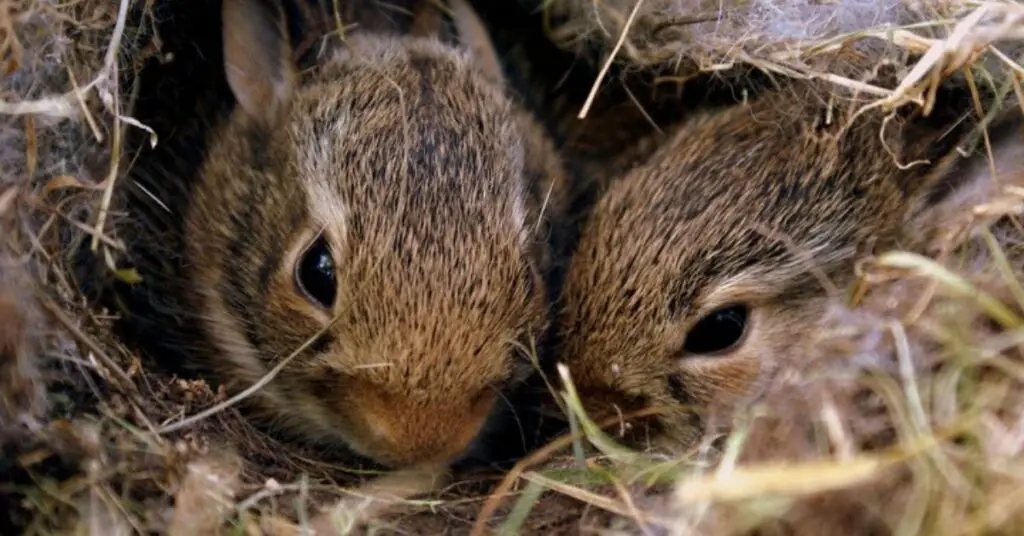
Beyond their structural ingenuity, squirrel vacation homes serve as fascinating insights into animal behavior. Squirrels often inhabit multiple nests throughout their territory, creating a network of safe havens for resting and rearing young. This nomadic lifestyle emphasizes adaptability and resourcefulness, characteristics that humans could learn from as our own living situations become increasingly complex.
Whether nestled high in tree branches or tucked away within dense foliage, a squirrel’s nest is not just a home; it’s a testament to nature’s brilliance in crafting survival strategies against predators and harsh weather conditions. Exploring these natural habitats opens our eyes to the hidden wonders that dwell right above us in the treetops!
A Squirrel Nest Timeline
The lifecycle of a squirrel nest is fascinating, reflecting not only the adaptability of these intelligent creatures but also their intricate social structures. Squirrels typically begin building their nests, or dens, in late winter to early spring when the maternal instinct kicks in with the approach of mating season.
Using twigs, leaves, and bark, they craft cozy refuges high up in trees or within hollow trunks—ensuring safety from predators while creating a warm environment for raising young.
Once constructed, a squirrel den serves multiple purposes throughout the year. To birthing and nurturing kits during spring and summer months, it becomes a storage site for food gathered during fall. These intelligent animals demonstrate remarkable planning capabilities; by stockpiling nuts and seeds nearby, they ensure sustenance even when winter makes foraging difficult.
As seasons change, so do nest locations—squirrels will often relocate to adapt to environmental conditions or human disturbances while maintaining their resourcefulness as survival experts. Observing this wildlife layer can offer deeper insights into ecological balance and the importance of preserving natural habitats where these vibrant creatures thrive.
Preventing Squirrels From Eating Bird Seed
To understand how to prevent squirrels from munching on your bird seed, it’s helpful to know what does a squirrel nest look like and whether do squirrels make nests. Squirrels nests, commonly referred to as dreys, are typically constructed from twigs, leaves, and other natural materials found in trees.
These nests are usually round and bulky, resembling a ball shape that can be between 18 inches to 2 feet in diameter. They are often high up in the treetops or tucked within tree cavities for protection against predators.
Indeed, squirrels make nests for more than just shelter; they also use them for breeding and raising their young. This makes understanding their nesting habits crucial when trying to keep them away from your bird feeders.
By recognizing where these clever creatures establish their homes, you can obstruct access points by trimming back branches or positioning feeders further away from potential nesting sites. Using squirrel-proof feeders can be an effective strategy since they not only safeguard birdseed but also deter these agile critters from reaching your avian dining area altogether.
Focus On Placement
To effectively prevent squirrels from raiding your bird feeders, it’s essential to understand where do squirrels nest and their nesting habits. Squirrels typically build nests in trees, often high up in branches or within the hollows of large trunks.
These nests, known as dreys, are constructed from a mix of leaves, twigs, and other natural materials. Knowing this can help you identify nearby squirrel activity; if you spot a drey in a nearby tree, it indicates that you might have unwelcome visitors at your feeders.
Understanding do squirrels build nests sheds light on their seasonal behavior. During spring and summer months, they are especially resourceful as they gather food to stash away for winter. This makes bird seed an attractive target! To deter these persistent critters from reaching your feeders, consider placing them away from trees or using squirrel-proof designs with baffles that thwart their climbing attempts.
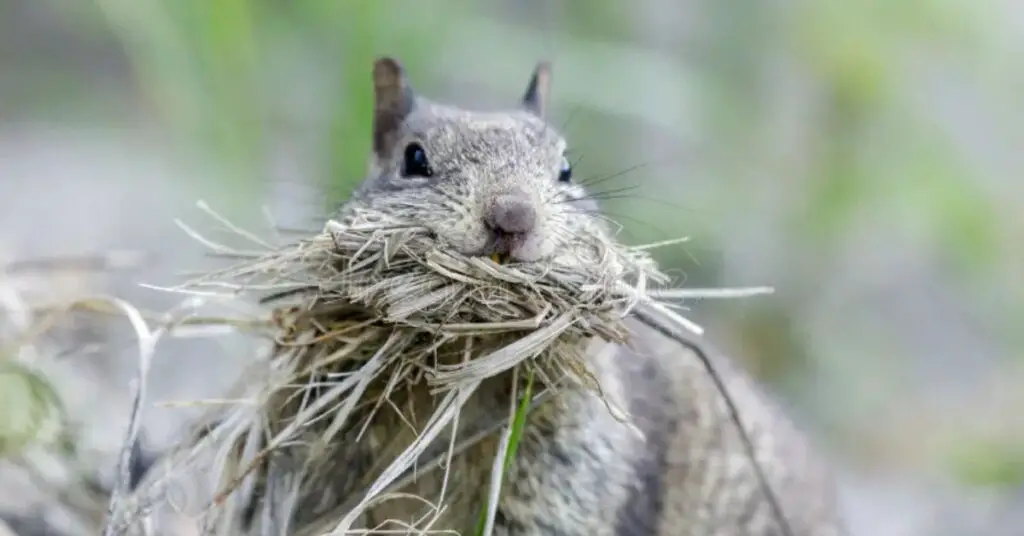
By strategically positioning your bird feeders and being aware of local squirrel nesting activity, you can create a more peaceful environment for your feathered friends while keeping those cheeky squirrels at bay.
IIf you love hummingbirds and are looking for the best place to set up a hummingbird feeder, check out our article: “Tips for Placing a Hummingbird Feeder.“
Select The Best Type Of Squirrel-Resistant Feeder
Choosing the best type of squirrel-resistant feeder is essential for bird enthusiasts who want to protect their feathered friends’ food supply. Look for features such as weight-activated perches or cages that deter squirrels while allowing birds of various sizes access to the seeds.
These feeders are designed ingeniously so that a squirrel’s weight triggers a closing mechanism, preventing them from reaching the food. Consider placing your feeder near a tree but far enough away to limit easy access; this strikes a balance between avian convenience and squirrel prevention.
As fascinating as they are adorable, some might wonder: do squirrels push babies out of their nests? While it’s not uncommon for young animals in nature to face tough love from their parents, mature squirrels typically ensure the safety and well-being of their offspring until they’re ready to leave the nest.
Understanding these dynamics can help bird enthusiasts appreciate the larger ecosystem at play when considering a well-situated squirrel home around feeding areas. By being proactive with well-designed feeders and understanding local wildlife behavior, you can create an engaging backyard space where both birds thrive without being overshadowed by curious squirrels.
Change The Taste
To effectively prevent squirrels from devouring your bird seed, consider changing the taste of the offerings. Many gardeners have found success by mixing cayenne pepper or other spicy seasonings into their bird seed; birds are generally unaffected by these changes, but squirrels tend to steer clear.
This strategic alteration not only protects your feathered friends’ food sources but also introduces intriguing flavors that may attract a wider variety of birds.
When encountering a squirrel in a tree, take a moment to observe its behavior for signs of a pregnant squirrel. While it can be challenging to identify pregnancy at first glance, increased foraging activity and nest-building behaviors may indicate that the little creature is preparing for new arrivals.
Understanding these natural cycles can inform how you manage feeding areas and adjust your tactics further—creating barriers or using baffles could deter hungry mothers-to-be while still ensuring the safety and sustenance of your avian visitors.
Monitor Feeder Activity
To preserve your bird feeder’s bounty, understanding the behaviors of squirrels can be crucial. The sight of a squirrel on a tree, eyeing your birdseed with mischief, is all too familiar for many bird enthusiasts. While these agile little creatures are often entertaining to watch, they can quickly decimate your supply of seeds if left unchecked.
One effective strategy is to position feeders away from close climbing branches or consider using baffles that thwart their ascent. By carefully monitoring feeder activity and observing how squirrels engage with their surroundings, you can implement preventative measures before they become a nuisance.
While some might ponder do squirrels eat grubs in their quest for food, these nimble critters predominantly prefer easy-to-access corn and seeds over insects.
Offering alternative feeding stations stocked with unsalted nuts or sunflower seeds placed further away from your aviary-friendly setup may also divert them from raiding the primary source meant for birds. This simple act not only safeguards the nourishment intended for feathered friends but simultaneously allows you to enjoy watching both birds and curious squirrels without distressing competition at the dinner table.
Understand How Persistent They Are
Squirrels are notoriously persistent when it comes to raiding bird feeders, leveraging their incredible agility and determination to snatch up those precious seeds. Understanding the lifespan of these crafty critters—how long do squirrels live?—can provide valuable insight into their behavior.
Generally, grey squirrels can live up to six years in the wild, and even longer in more protected environments. This longevity means that if you have a well-fed squirrel population around your yard, they’ve likely become adept at overcoming various feeding challenges.
One ingenious way to deter squirrels is by installing a specialized squirrel house away from your bird feeders. Squirrel houses not only provide an alternative food source but also serve as an engaging distraction for these clever animals.
By attracting them elsewhere with appealing nesting options or food stations stocked with corn and other treats, you can reduce their inclination to invade your bird feeders.
Squirrel Benefits
Squirrels often go unnoticed in our backyards, but they provide numerous benefits to local ecosystems. One of the most fascinating aspects of their life is the construction of squirrel houses, which can inspire homeowners to create similar habitats.
Squirrel houses not only offer shelter for these adorable creatures but also contribute to seed dispersal and forest regeneration by helping plant life thrive. By providing a dedicated habitat, you encourage these agile acrobats to thrive in your yard, enhancing biodiversity and promoting a vibrant landscape.
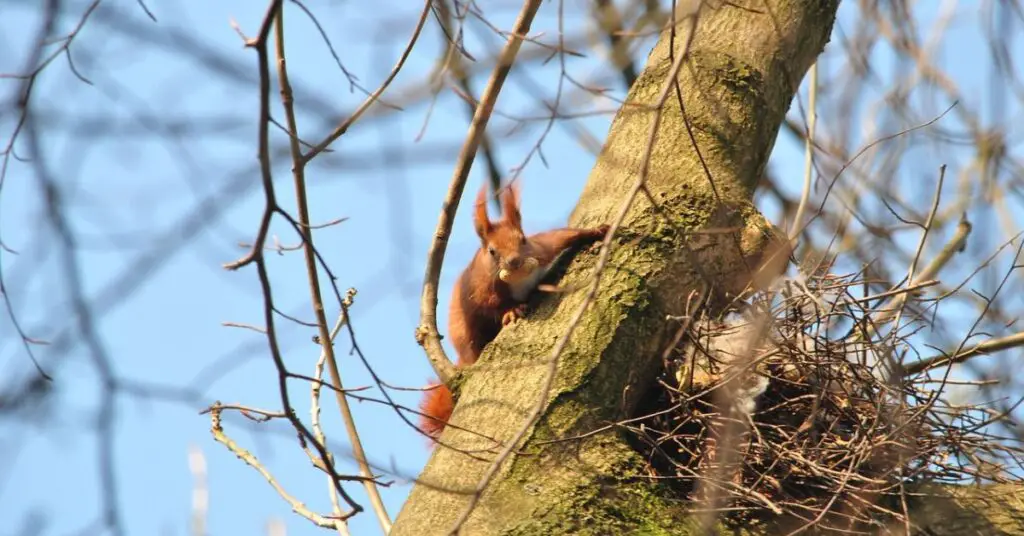
Understanding how long squirrels live can also deepen our appreciation for these lively animals. Typically, their lifespan ranges from 6 to 12 years in the wild, depending on environmental factors and predation risks. In safe environments like parks or closely monitored habitats—especially with the presence of squirrel houses—they may reach their full potential longevity.
Conclusion
Squirrel nests are fascinating structures that provide essential shelter and safety for these agile creatures. Composed of twigs, leaves, and other natural materials, these nests showcase the squirrels’ remarkable ability to adapt to their environment. Understanding the different types of nests—such as dreys and tree cavities—can deepen our appreciation for these resourceful animals and their behaviors.
By observing squirrels in their natural habitat, we can gain insights into their lifestyles and the ecological roles they play. So next time you encounter a squirrel in your backyard or local park, take a moment to appreciate the complexity of its nest and consider how you can contribute to preserving its habitat.
FAQ’s
What Are Names For Squirrel Nests?
Squirrel nests are commonly referred to as dreys. These structures are typically made from twigs, leaves, and other natural materials, and they serve as a safe haven for squirrels to rest, raise their young, and escape from predators.
Dreys are usually built high in the branches of trees to provide protection and insulation.
How To Make A Squirrel Nest?
Making a squirrel nest, also known as a dreys, can be an interesting project if you’re looking to support local wildlife. Squirrels typically build their nests high in trees using twigs, leaves, and other natural materials.
To create a suitable environment for them, you can start by selecting a location that is elevated and sheltered from harsh weather conditions. Ideally, this should be in the branches of a sturdy tree or shrub where squirrels are already active.
What Does A Squirrel Eat?
Squirrels are primarily herbivorous and have a diverse diet that includes a variety of plant materials. Their primary food sources consist of nuts, seeds, fruits, and vegetables. Common nuts that squirrels enjoy include acorns, walnuts, hazelnuts, and pecans.
They are known for their ability to locate buried nuts during the winter months, demonstrating their remarkable memory and foraging skills.
- How To Keep Bees Away From Hummingbird Feeders - March 20, 2025
- How To Attract Owls To Your Yard - March 11, 2025
- Breeding Season For Wild Birds - March 9, 2025
